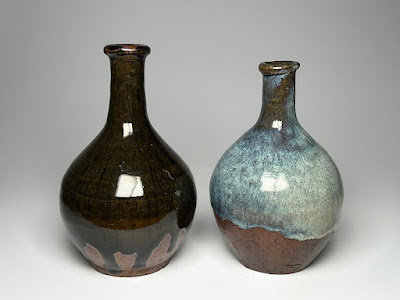仙北地方の小さなすず Small Bottle from Senboku Region
高さ height: 15.0 cm / 胴径 body width: 9.7 cm
人間は外部から入ってくる情報にフィルターをかけて、そのほとんどを捨て去り、関心のある情報だけを選択して取り入れるという。骨董あつめをしていても同様のことがあるらしく、なにか品物を目にしてそれに「開眼」すると、それまでは気にもかけなかった類似の品物が俄然目につくようになる。
ちょっと前に秋田の白岩焼とおもわれる小さなすず(徳利の古い呼び名)を紹介したが、それから1ヶ月と経たないうちに同様の品をもう1個手に入れた。褐色の下釉の調子や胎土のかんじが似ていることから、これも白岩焼だと思う(ただし旧南外村の楢岡焼などの可能性もある)。容量もおなじくらいでだいたい1合半(270 ml)。このサイズのすずは秋田あたりではかなりめずらしいと思っていたのだが、いままで気づかなかっただけで実はけっこう現存しているのかもしれない。
A human being filters out most of the information that comes from outside, and accepts just what is interesting. This also happens in antique hunting. Once I recognize how valuable something is, I become aware of similar things that had never come into sight before. I have recently shown an old Shiraiwa small bottle, and after a month or less, found another one that was likely a Shiraiwa ware because the brown glaze and the clay's quality are nearly the same. The volume is also about 270 ml. I thought that this size of Shiraiwa bottles was rare, but there might remain not a few.
前のすずとは
- 出っ張った高台がついている(前のは碁笥底高台)
- 上釉が黒みがかっている
ところが異なる。色に関して言うと、これはなまこ釉の発色がうまくいかなかった、ある意味失敗作とも考えられるし、あるいは黒唐津のような色をあえて狙ったのかもしれない。「白岩瀬戸山 復刻版」(原著:渡辺為吉、満留善、1979年)に掲載されているすず(下を参照)など、白岩ではこうした黒釉の器がないわけではないことから、おそらく後者だろう。同書は窯跡の陶片や伝世品の特徴について記述しているが、その中にも「黒釉」の文字がいくつか確認できる。
Differences between these two bottles are found in the design of the bottom rim and the glaze color applied over the brown coating. The black glaze is not very common in the Shiraiwa pottery but some did exist. For example, the photo below is quoted from a Japanese book, Shiraiwa seto-yama that was originally written by Watanabe Tamekichi in 1933 and reprinted in 1979. This book also described that there were some black-glaze products and fragments abandoned around the kilns.




